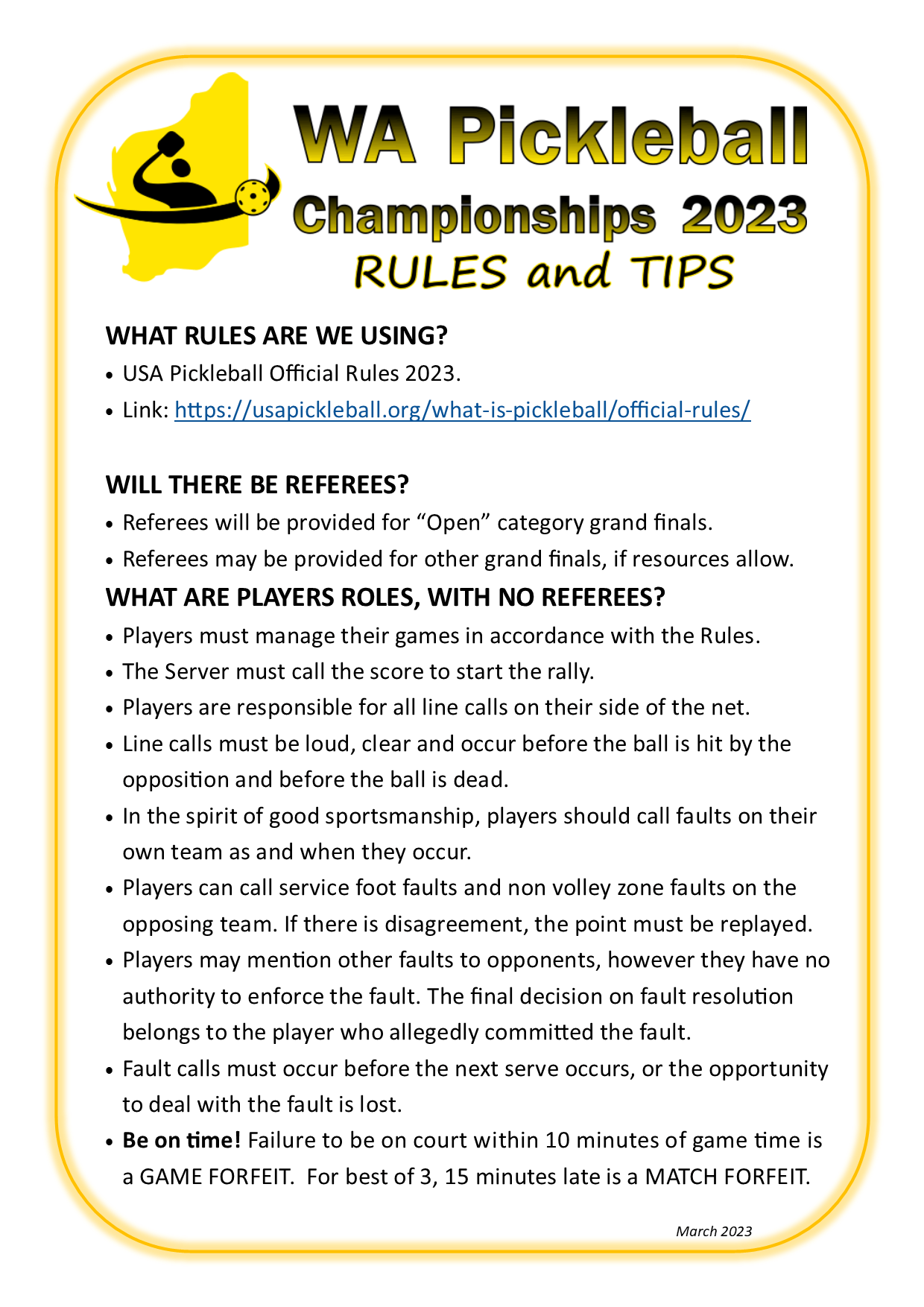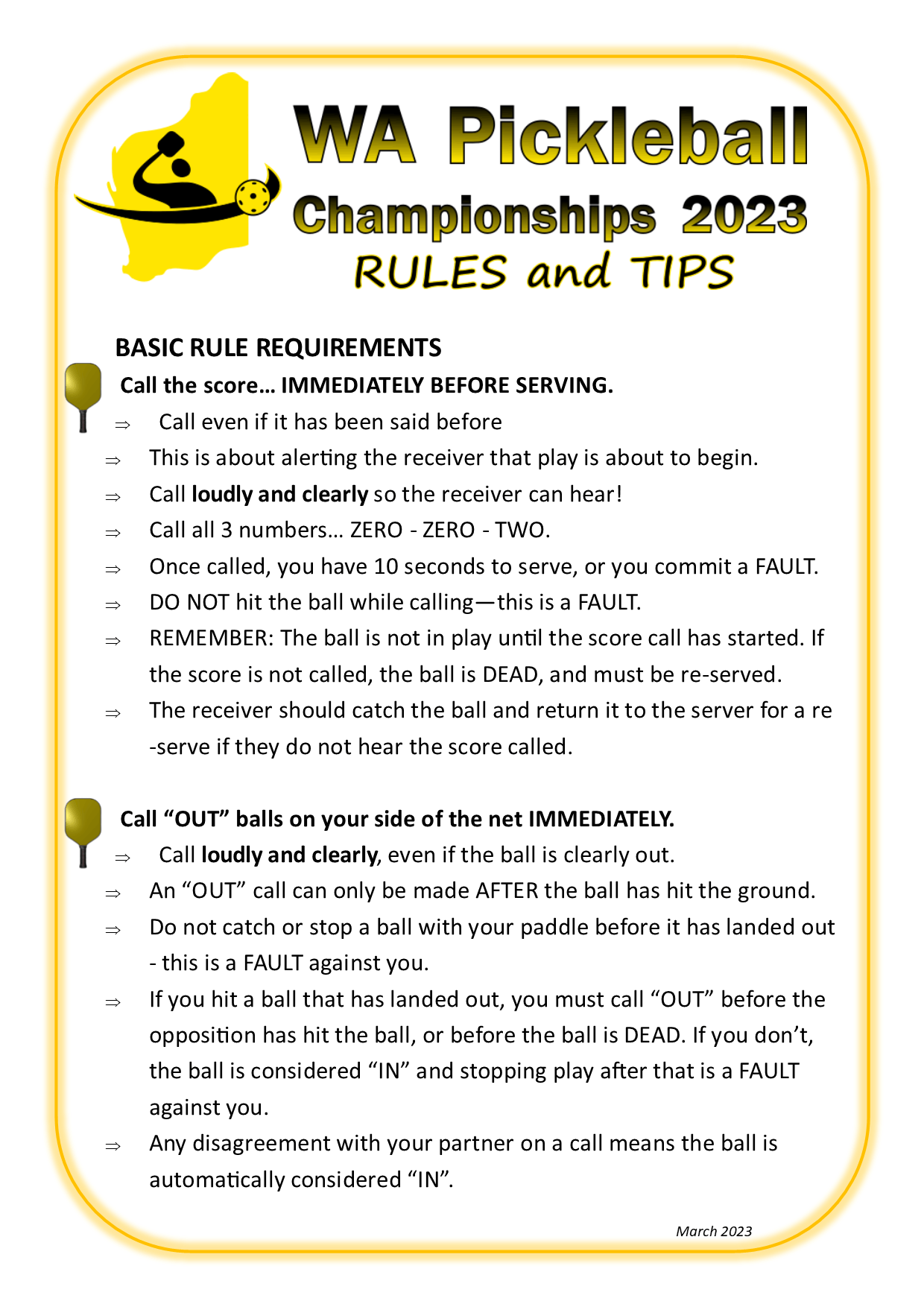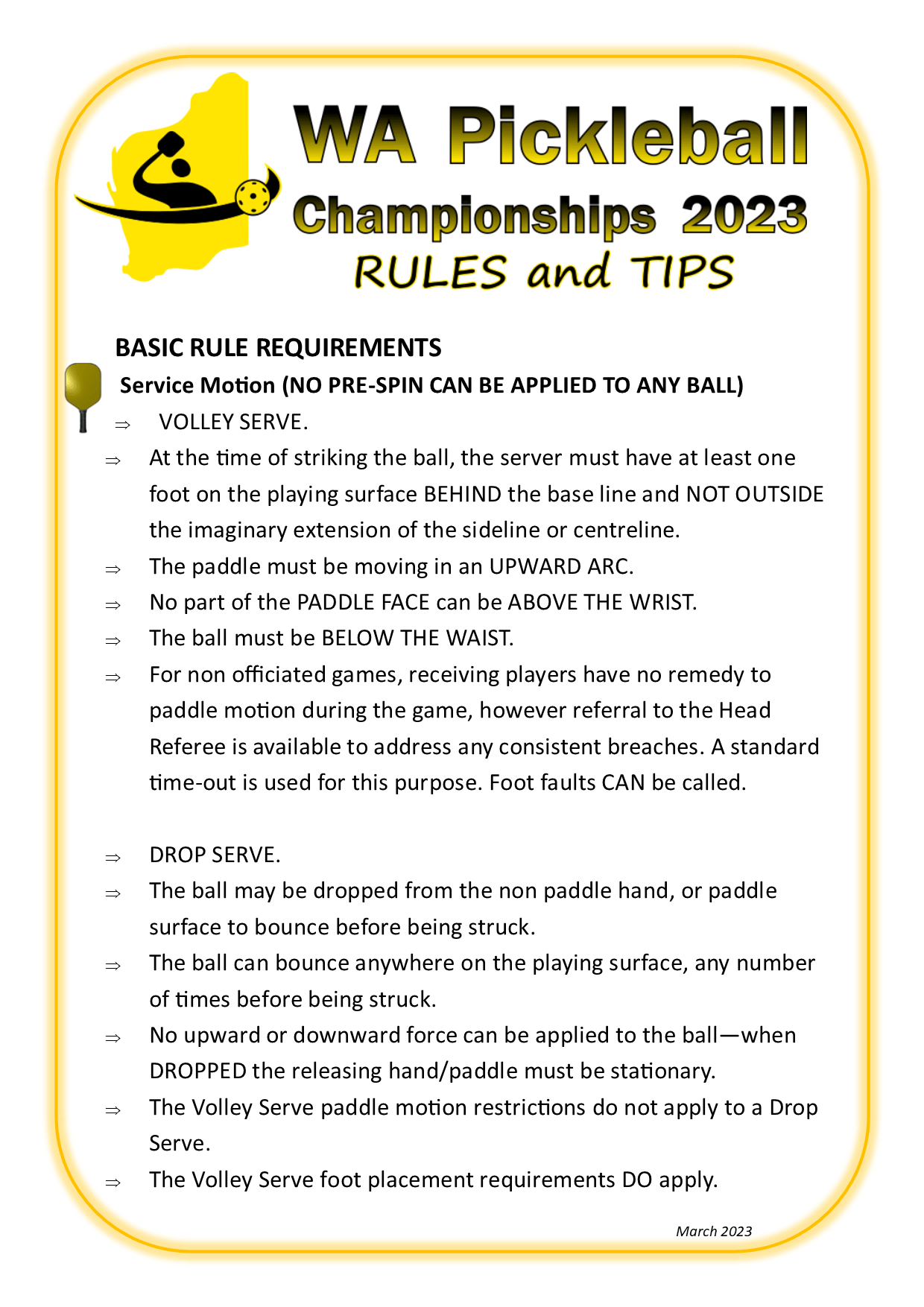- WA Pickleball Championships 2023 (completed)
- WA 50+ Classic Doubles (Completed)
- Western Australian Mixed Doubles Summer Championship (Completed)
- Western Australian Pickleball Championship 2024 (Completed)
- Western Australian Singles Classic 2024
- Western Australian Doubles Classic 2024
- Participate
- Members
- Contact

Sponsored by...

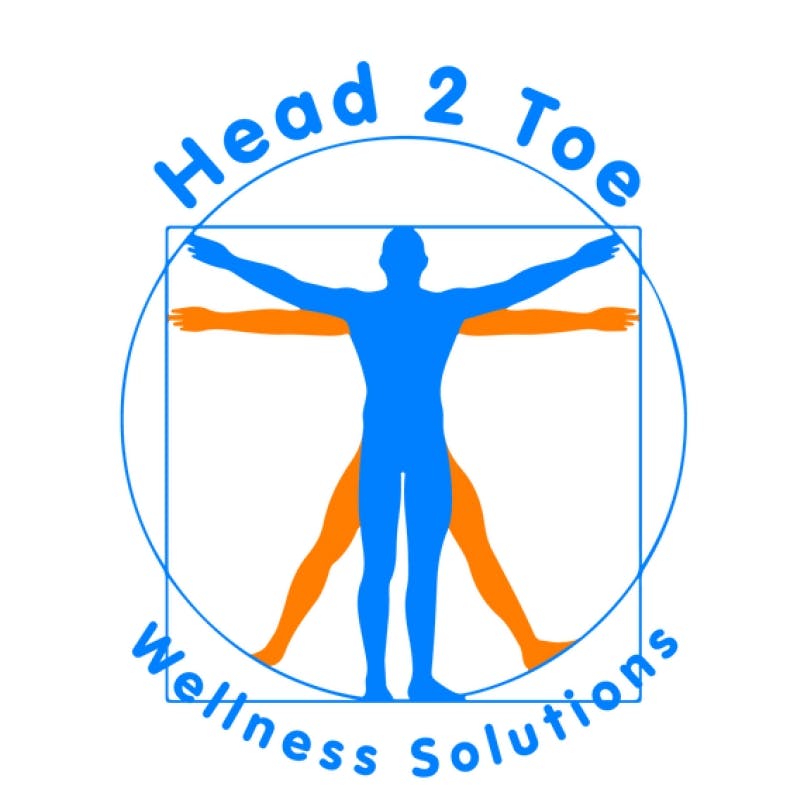

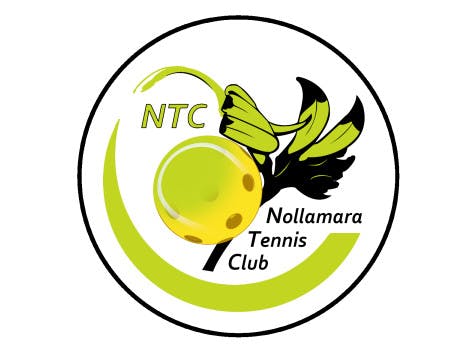
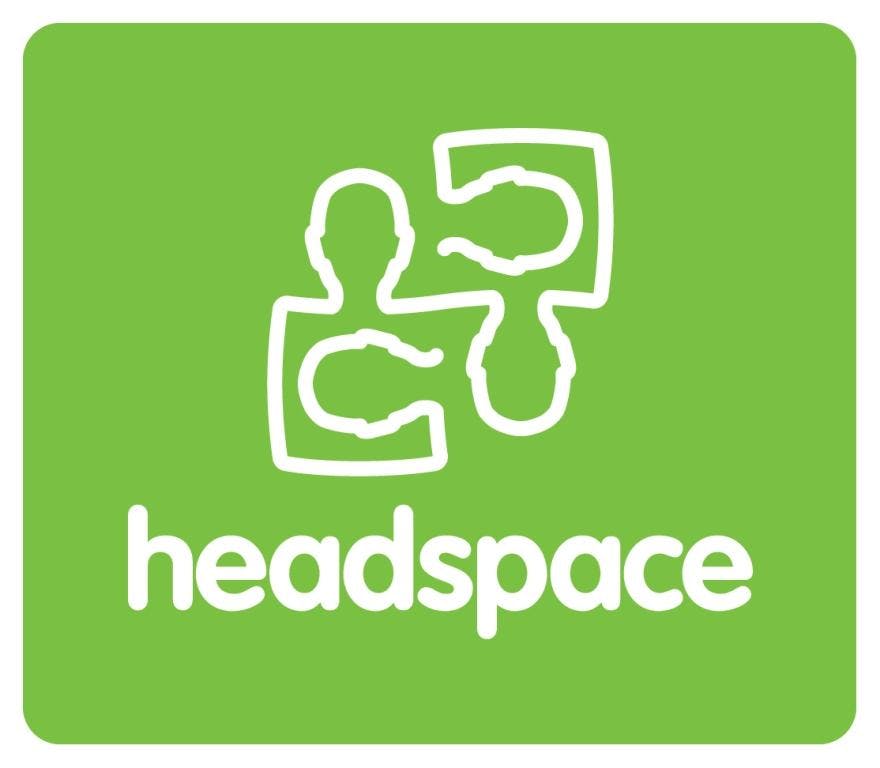


RULES and INFORMATION
PLAYER RULES (Download PDF)
Referees and Rules Summary
Player Instructions
Please carefully read this important information in its entirety.
All 2023 USA Pickleball Rules Apply
Key points of the Western Australian Pickleball Championships 2023 rules are summarized below for your convenience. However, as a player, you are responsible for being familiar with the rules in their entirety.
COURT ETTIQUETTE
• If your game ball rolls onto another court, do not run onto the court or call out to players while they are playing their rally. Calling of a hinder is the responsibility of the players on the affected court.
• If a ball rolls onto your court, pick it up and identify where it came from and get an acknowledgement from the relevant court before passing it back to a specific player.
• When moving to your allocated court for the game start, look for a folder containing the correct scoresheet, a basket containing 2 balls and coin. If it is not there, please refer back to the control desk before commencing your game.
• No alcohol or glassware of any sort is to be taken onto the courts.
• Footwear with non-marking soles should be worn.
• No spectators (or non-playing participants) are to be in the court enclosure, to ensure the safety of both players and spectators, and prevent any distraction to players.
• Smoking is not permitted inside the perimeter of the property (including the carpark) bounded by the exterior fence.
MAJOR NEW RULES FOR 2023
• If your apparel colour approximates the colour of the ball, the Tournament Director may request you to change your apparel. Failure to comply with an apparel change request may result in the forfeit of your match. (Rules 2.G.1, 2.G.4)
• The server must use only one hand to release the ball to serve and must not spin the ball during its release. (Rule 4.A.5)
• If the referee is not certain that your serve complied with the service motion or ball release requirements, the referee may call for a re-serve. (Rules 4.A.9)
• The question “Am I good?” is considered to encapsulate “Am I the correct server or receiver and am I in the correct position?” (Rule 4.B.8)
• If the referee or the server calls the wrong score, you can stop play to challenge the score before the return of serve. Otherwise, the correction will be made at the end of the rally. (Rule 4.K)
• If you stop play after the serve is made and the score was called correctly, this is a fault against you.
• If you stop play after the serve is returned, this is a fault against you.
RULES OVERVIEW
1. Players must play with a USA Pickleball-approved paddle. You are responsible for ensuring that the paddle you play with is listed on the Approved Paddle List posted on the USA Pickleball website.
2. Players are responsible for calling all the lines on their end of the court. However, in officiated matches, the referee is responsible for calling service foot faults, non-volley zone foot faults, and short serves. Please make all “out” calls loudly, clearly, and promptly, even if they are obvious. The Code of Ethics for Line Calling requires that you give the opponent the benefit of any doubt and call “out” only if you can clearly see space between the ball and the line when it hits the ground. (Rule 6.D.6)
3. You may ask the referee to make a ruling on any line call. The referee will only make a ruling if he/she clearly saw the ball land. Otherwise, the appealed call will stand.
4. Spectators are not to be consulted over any line call.
5. Starting server bands will be provided for doubles events and must be worn by each starting server so that is visible to the referee and the opponents. Failure to wear the band will result in a forfeit of the match.
6. Referees, and servers in self-officiated matches, will make sure all players are ready (or should be ready) before calling the score.
7. The server must not hit the ball to serve until after the entire score has been called. REMEMBER: in doubles, the score is 3 numbers, not 2! Serving while the score is being called (live ball) will result in a fault. Serving before the score call begins (dead ball) will result in a replay.
8. After the score is called, the server has 10 seconds to serve the ball. Failure to do so will result in a fault.
9. Before the serve is hit, players may ask the referee who is the correct server or receiver, whether they are in the correct position, or to confirm the score.
10. In officiated matches, the referee will pay close attention that each player’s service motion complies with USA Pickleball requirements. The ball release must also be visible to the referee and the receiver.
For a volley serve, when the ball is hit:
a. The server’s arm must be moving in an upward arc.
b. The highest point of the paddle head must not be above the highest point of the server’s wrist.
c. The ball must not be above the server’s waist.
For a drop serve, the ball must be dropped from the hand or paddle, with no force added, from an unaided height.
11. Any carry, or double hit, must be unintentional and be one continuous motion.
12. Players may quickly hydrate and towel off between rallies within the flow of the game.
13. Players may call a hinder if they are distracted by a ball, person, or object coming into their playing area. Hinders deemed to be valid by the referee will result in a replay. The referee will not stop play due to a ball in the playing area unless it becomes a safety issue.
14. Players may only receive coaching from someone other than their partner during a timeout. This includes between games and during end changes.
15. Any player may call a time-out before the server hits the ball to serve. Each team has two 1-minute (standard) time-outs per 11-point or 15-point game and three time-outs are available in games to 21 points. Time-outs cannot be called during rallies. Time-outs for a game may be requested and used during the between game time-out before the game resumes.
16. There is a 2-minute break (time-out) between games.
17. In the third game of a 2-out-of-3 game match, and in games to 15 or 21 points, teams have a 1-minute time-out to change ends of the court (at 6, 8, or 11 points, respectively).
18. Each player may request one medical time-out per match to address injuries and medical conditions. When a player requests a medical time-out, medical personnel (or the Tournament Director) will be summoned to assess whether the need is valid. If the request is deemed not valid, the requesting player will be charged a standard time-out (if available) and issued a technical warning. If the player has no remaining time-outs, a technical foul will be issued (resulting in a 1-point score adjustment).
19. In the interests of player wellbeing, any player sustaining a head injury will not be permitted to resume play without a written release from a licensed health care professional.
20. Players requesting to see the Head Referee or Tournament Director to challenge a referee’s ruling will be charged a standard time-out and be issued a technical warning if the referee’s ruling is correct. If no time-out is available, a technical foul will be issued (resulting in a 1-point score adjustment).
21. When 15 seconds remain before starting or resuming play, the referee will give a 15-second warning. The referee will call “time in” and the score when the players are, or should be, ready.
22. In self-officiated matches, any player may request a referee if the player believes that a rule is being consistently violated or when players are not able to resolve a dispute quickly and easily.
23. Players are expected to exhibit good sportsmanship at all times. Any action deemed by the referee to be unsportsmanlike will result in a verbal warning, technical warning, or a technical foul against the offending player. A game will be forfeited if the player or team receives a technical warning and a technical foul, or three technical warnings, during a match. The match will be forfeited if the equivalent of four technical warnings is obtained.
WHEELCHAIR RULES OVERVIEW
1. Players using wheelchairs may allow the ball to bounce twice before returning the ball. The second bounce can be anywhere on the playing surface.
2. Players using Wheelchairs - Any person, with or without a disability, who plays the game in a wheelchair. The wheelchair is considered part of the player's body. This can be a player with a disability or anyone that wants to play in a wheelchair.
3. The moment the ball is served: Both rear wheels must be on the playing surface behind the baseline and may not touch the court on or inside the baseline or outside the imaginary extensions of the sideline or centerline.
4. Failure of a player using a wheelchair to return a ball before it bounces three times on the receiving player's side of the net is a fault.
5. All volleys must be initiated outside of the non-volley zone. For players using wheelchairs, the front (smaller) wheels may touch the non-volley zone during a volley.
6. It is a fault if the volleying player or anything that has contact with the volleying player while in the act of volleying, touches the non-volley zone. For players using wheelchairs, the front (smaller) wheels may touch the non-volley zone.
7. During the act of volleying, it is a fault if the volleying player's momentum causes the player to contact anything that is touching the non-volley zone, including the player's partner. For players using wheelchairs, the front (smaller) wheels may touch the non-volley zone.
8. If the rear wheels of a wheelchair have touched the non-volley zone for any reason, the player using a wheelchair cannot volley a return until both rear wheels have made contact with the playing surface outside the non-volley zone.
9. Players using wheelchairs may play in Men's Doubles, Women's Doubles or Mixed Doubles with either standup partners or wheelchair doubles.
